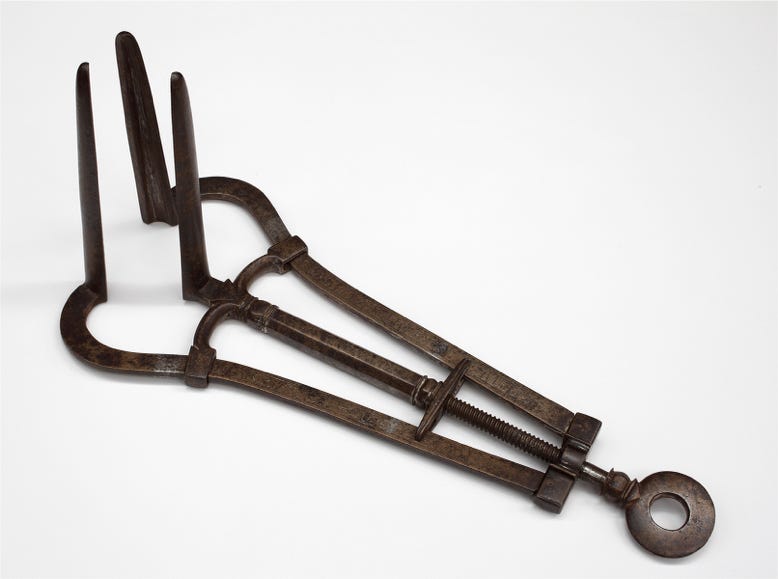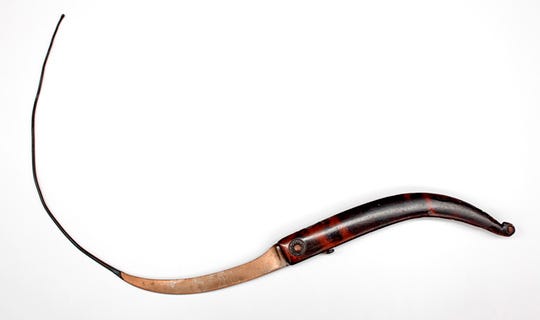The portraits of the ancien regime never show an open smile and for good reason. In an age where a sense of hygiene was not unheard of but not quite understood either dental hygiene was far from perfect.The habit of brushing one's teeth did not really come into force until after the fall of Versailles which meant that most courtiers - the royal family included - had serious dental issues.
Upon his birth Louis XIV was noted to have two teeth already in place. As mentioned in an earlier post the King's teeth caused him problems throughout his life. In the 1680's he experienced increasing bouts of toothaches and had to undergo several oral surgeries where his teeth were pulled. One particular painful incident occurred in 1685 when a molar had become so painful that it had to be extracted. The lack of properly cleaning the wound meant that the King would have infection in his mouth - which resulted in the necessity of pulling out more teeth.
By 1712 the King finally appointed a special dentist who would see to the Grand Monarch's few remaining teeth.
 |
The Grande Dauphine who was never
blessed with good teeth |
Like her husband Marie Thérèse could not boast of having a dazzling smile. On the contrary both her and her daughter-in-law, Marie Anne Victoire of Bavaria, were plagued with having rotten teeth. In the Queen's case her mouth was described as being "black" due to the extremely poor condition of her teeth. At the time the Queen's poor dental state was said to stem from her eating too much chocolate and garlic. The Grande Dauphine's teeth were already poor before she ever made it to the French court.
When Marie Adélaide of Savoy was chosen as the bride for the Duc de Bourgogne it was with great pride that her French-born mother could tell of her white teeth. In this instance the teeth in question actually were white to the relief of Louis XIV and his court.
Louis XV was thought to be the handsomest man at his own court but his teeth were not immune to the troubles of his day. In 1742 he had a tooth extracted which sadly damaged his good looks somewhat according to the Marquis d'Argenson. However, the King himself was not all that concerned about how his appearance was affected; after all having teeth pulled was something that only a very small handful of people could avoid. His regret was that he would miss out on hunting for two whole days.
In 1755 Louis XV was presented with a new invention by a Dr. Julien Botot; the odd mixture was called a toothpaste. Later the dentist would also present the King with mouthwash flavoured with anise. It can be said that the doctor dedicated his invention to the King out of gratitude. After all, it was thanks to a royal decree from 1741 that dentists achieved a status of their own and no longer had to be counted among the odd charlatans.
 |
Toothpaste and mouthwash as invented by Botot (with
modern hygienic standards) - this is not far from what
was presented to Louis XV |
During the 18th century the fact that having decaying teeth could be actively avoided was gradually being spread. Consequently, a wide array of products for the teeth emerged alongside the inventions of Dr. Botot. Courtiers began to wash their teeth in the same manner as one would wash one's hands. Some sought to preserve the whiteness of their teeth by using these new products. Mademoiselle d'Elboeuf applied a white paste to her teeth for that very purpose. In the reign of Louis XVI it was common to have certain waters to wash one's mouth with; these were often scented with lavender or cloves.
It was not merely a question of appearances that made dentistry important to the royal family. Especially young children - who were already vulnerable - could potentially die from a bad tooth. Sadly, this happened to a daughter of Philippe II d'Orléans (better known as the Regent) who died in Versailles in 1748. Her autopsy placed the blame for her demise squarely on her dental issues.
Madame Victoire (one of Louis XV's numerous daughters) had to have a tooth extracted at the age of fifteen but she was terribly afraid of the procedure. She continued to have it delayed; her father and brother, the Dauphin, had a two-hour long private conversation about the necessity but she was not quite convinced. In the end, though, she resolved to have it done on the condition that that her father and mother would hold down her arms while Madame Adélaide should restrain her legs.
 |
| Madame Victoire |
By this time a dentist was well-established in the royal households. As it happens it had been Monsieur Claude Mouton - dentist to Mesdames - who had recommended the pulling of Victoire's tooth.
Poor Louis XVI whose appearance was never as charming as his grandfather's was not made handsomer by his smile. His teeth were misaligned which prompted a page of his to render his laughing "graceless". He had actually been born with erupted teeth as well but unlike those of his Louis XIV they were not considered to be a mark of greatness to come.
When Louis XV was negotiating with Empress Maria Theresia over the union between their two countries the portrait of the Dauphine-to-be, Marie Antoinette, was put under close scrutiny. One particular flaw was found to be great enough to need amendment before the marriage could happen: the archduchess' teeth were crooked. However, a new French invention came to the rescue. It was known as "the Pelican" and involved using wires to straighten teeth. So, the young Antonia had the wires placed and wore them for three months - she was left with neat regular teeth.
 |
Marie Antoinette as a child before her
excessive dental surgery |
The problem was that while everyone expected to suffer from some sort of dental issues during their lifetime there was no excuse for having ugly teeth. As Marie Antoinette's teeth were required to be mended so was her sister-in-law, the Comtesse de Provence, been chided for her teeth. In her case Louis XV thought it necessary to write to the young woman's father, the King of Savoy, to criticise his daughter's oral hygiene. The French King made a slightly cutting remark stating that although attention to teeth was not highly esteemed in much of Europe it certainly was at Versailles.









